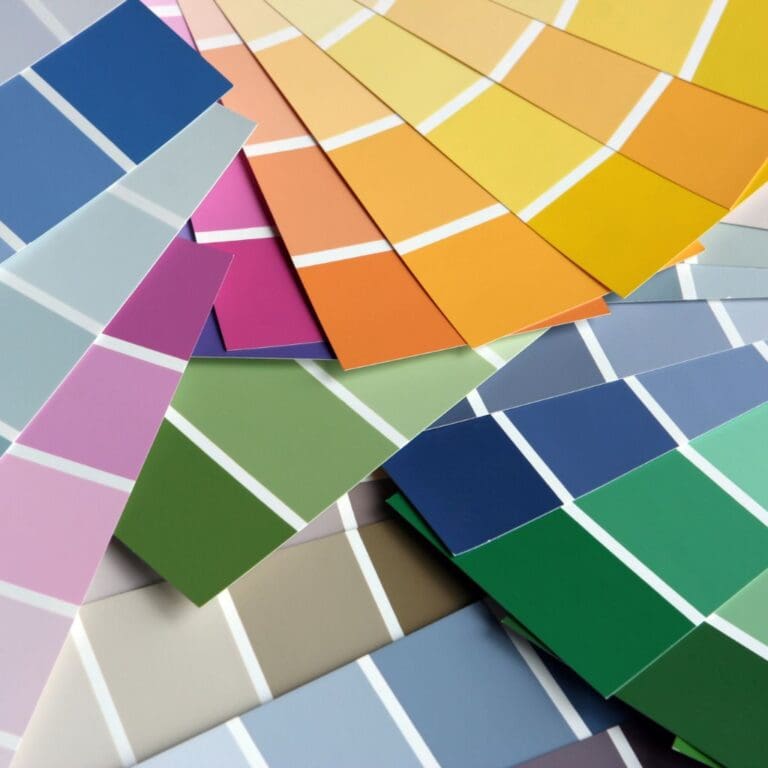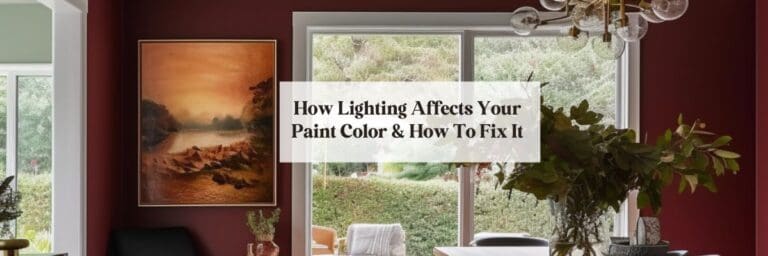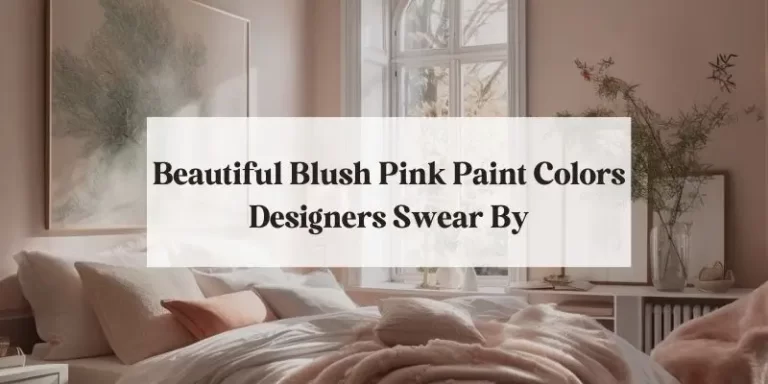Designer Tested Beige Colors To Elevate Your Home
Beige is so boring. Not! Beige is back, baby. And it’s not that dusty 90’s beige we all cringe over. Today’s neutrals are elegant and sophisticated. Paired with deep accent colors like plums, blacks, dark greens, and deep purples these new neutrals can make your room look chic and styled with just a quick paint job.
We’re going to dive into the mechanics of these modern beige colors so you can confidently choose the right beige paint color for you. I’m also sharing my top light, cool, warm, and dark neutral paint colors that have been tried and tested by designers all over the world so we know they work.
Looking for more paint color inspiration? Check out our previous posts on red, pink, orange, yellow, green, blue, purple, black, and white for a fun deep dive into the meaning and psychology of these colors and how best to use them in your home.

Bold, Beautiful Beige & Neutral Colors
Beige paints all look alike, right? Not so fast. The reason beige paint can be so challenging is because each beige has different undertones.
What are undertones? Well, let’s demystify them so you can quickly and easily pick the right beige paint for any space in your home.
Color Undertones & How They Affect Your Paint
Every color, even black and white, is made from a highly calculated paint formula that mixes different colors to get that perfect shade you see in all of the magazines.
Undertones are very slight colors mixed in the paint formula to get the rainbow of different shades from white to red to black. These color undertones are hard to spot on a small paint swatch, but very noticeable once painted over all four walls.
We’re going to walk through the different types of neutrals so you can accurately spot the undertones in your paint, and make an informed decision on what beige color looks best in your room, and avoid those timely and costly trips to the hardware store.

Know Your Neutrals
Beiges can range from light and subtle to cool neutrals, warm neutrals, and finally deep, rich earthy beiges. Knowing how to spot which category your color falls in will help prevent “paint freeze” aka indecision.
The Four Categories of Neutral Colors
Not all neutrals are built the same. There are four categories of neutrals that can help you decide which is best for your space. All beiges and neutral colors fall into pure, near-neutral, cool, and warm. Let’s see what each of these categories are about and how they’ll work in your home.
Pure Neutrals
Pure neutrals are white, black, brown, and gray. These colors are fully saturated and do not have any undertones in them. These pure colors are rarely used in interior design because of how bold they are. Many choose to go with a pure white to open up spaces, but that trend is starting to shift to warmer neutrals that aren’t so stark.
Near-Neutrals
Near-neutrals are pure neutrals mixed with a primary color like red, blue, or yellow. These mixed colors have a brighter vibrancy yet lower saturation of the pure neutral colors of black, white, gray, and brown.
These are your tans, ivories, and eggshells. They are subtle and well balanced with a hint of color behind it.
Cool Neutrals
Cool neutrals have a gray, blue, purple or green undertone to them. These are your taupes, grieges, and light bone ivory colors.
Warm Neutrals
Warm neutral colors have pink, red, orange, or yellow undertones. These are your goldenrods, tans, beiges, and warm whites.

How Lighting Enhances Undertones
Okay, so how do you know what category of beige will work in your specific space? Lighting, my friend. Are we shocked that it always comes down to lighting? Nope!
The very first thing you’re going to do before you even pick up your keys to trek down to the hardware store is to check which direction your windows face. Do your windows face North? Do you have one that is South, and the other is East?
Knowing the direction of your light will tell you some very important information.
The Direction Of Your Light Matters
The very first thing to know before diving into a sea of beige colors is to check which direction the natural light is coming from in your space. If you have North or East facing windows, the natural light will have a cooler cast to it.
This means that if you have a cool undertone in your beige paint color, the light will enhance that cooler color in your beige paint and make it look more blue, green, or gray than it actually is. To counteract the cool tone in North and East light, choose a slightly warmer beige for balance.
If you have South or West facing windows, your natural light will have a warm cast that will pick up any pink, red, yellow, or orange undertones in your beige paint.
This will turn your beige color into a rosy pink or orange creamsicle instead of that elegant neutral you were going for. Counteract the warm light with a slightly cooler beige that will cancel out these warmer undertones.
By knowing which direction your natural light comes from, you can narrow down your selections before you purchase by canceling out either warm or cool tones that won’t work for your space.

Sample Twice, Paint Once
Now to the fun part, testing your new found knowledge, picking out paint swatches, and sampling your gorgeous new paint.
I CANNOT stress this enough. If you’ve hung around this blog long enough, you’ve probably heard me say this a million times. You. Must. Test. Your. Paint.
This will be the hill I die on. I can see it now on my tombstone, “Here Lies Nicole. Her last words were, Sample Twice, Paint Once.” I kid, but I’m so dead serious here people.
Sampling your paint is THE MOST critical step in selecting any paint color. We can make the best educated guess when standing in the hardware store with those bright fluorescent lights overhead, but every color changes once you get it home in your specific lighting environment.
There’s nothing worse than being all excited about that beautiful color you agonized over, and are 100% sure it will look amazing in your room, only to find that it turned an ugly gray, or a dirty yellow once you painted it on all four walls. Let’s avoid the time, money, and energy by simply sampling your paint before your dive in. Here’s how to do it right, the first time.
Test Your Paint Like A Pro
Here’s a pro-tip that you won’t hear anywhere else, that will save you time and money.
Don’t paint your swatches directly on the wall.
Um, what? Where in the heck do you paint them?
Unless you’re in a new build with a contractor grade super-white, your wall probably already has some sort of color on it that will affect how your beige actually reads.
Instead, get some old-school poster board. That’s right, the kind of foam core board that you did your 8th grade science project on.
Paint a large swatch on your board, but leave about 2-4 inches of white space around your swatch. This will provide a clean, ultra white border around your paint sample to help you accurately see the true color of your beige.
Read The Room
Place your poster board samples around the room and check them in the morning, at midday, and at b. You want to see how your paint changes, and trust me, it will, at different times of the day.
Toss any samples that start to read overly cool or warm. If you notice these colors change over the course of the day on a small sample board, imagine how more noticeable that change will be once you paint it over all four walls!
Steady As She Goes
Choose the paint sample that looks best on all four walls, at the three different times of day. If your beige sample has minimal color shift, that’s the one for you.
The Best Beige Colors That Just work
Congratulations! You’ve made it! You’re a color-picking pro now, and you can confidently walk into any paint store armed with professional-grade knowledge that will make you look like a design star. Cue the theme music, and roll out the red carpet.
So let’s get to the good stuff! I’ve pulled together a comprehensive list of gorgeous beige paint colors that run the gamut from light beige, cool beige, warm beige, and dark beige to help get you started on picking a beautiful neutral for your space. These colors have been tried and tested in the field by designers all over the world so you know they work.

Sherwin Williams: Antique White SW 6119, Benjamin Moore: Soft Chamois OC-13, Farrow & Ball: New White No.59, Behr: Antique White 25.

Sherwin Williams: Accessible Beige SW 7036, Benjamin Moore: Pale Oak OC-20, Farrow & Ball: Turret White No.G2, Behr: Alpaca Blanket BWC-27.

Sherwin Williams: Natural Linen SW 9109, Benjamin Moore: Muslin OC-12, Farrow & Ball: Matchstick No.2013, Behr: Stucco Tan BWC-26.

Sherwin Williams: Balanced Beige SW 7037, Benjamin Moore: Manchester Tan HC-81, Farrow & Ball: Cord No.16, Behr: Even Better Beige DC-010
About The Author
Nicole Cullum is an interior designer and fine artist. Her passion for color, pattern, and balance are expressed through her hand-painted line of wallpapers, textiles and home decor available at ColorCaravan.com.
Contact Nicole at hello@ColorCaravan.com for your next design project, e-design services, or a custom pattern design to make your space truly unique.








